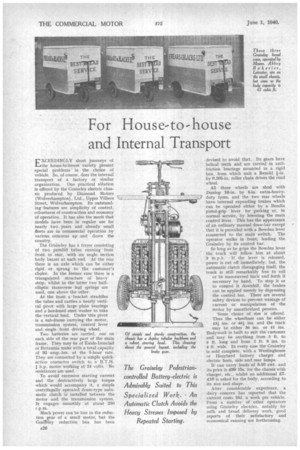For House-to-house and Internal Transport
Page 36

If you've noticed an error in this article please click here to report it so we can fix it.
EXCEEDINGLY short journeys of 1.--gthe house-to-house variety present special problems in the choice of vehicle. So, of course, does the internal transport of a factory or similar organization. One practical solution is offered by the Graiseley electric chassis produced by Diamond Motors (Wolverhampton), Ltd., Upper Villiers Street, Wolverhampton. Its outstanding features are simplicity of control, robustness of construction and economy of operation. It has also the merit that models have been in regular use for nearly two years and already small fleets are in commercial operation by various concerns up and down the country.
The Graiseley has a frame consisting of two parallel tubes running from front to rear, with an angle section body bearer at each end. At the rear there is an axle which can be either rigid or sprung to the customer's choice. In the former case there is a triangulated structure of heavy strip, whilst in the latter two halfelliptic transverse leaf springs are used, one above the other.
At the front a bracket straddles the tubes and carries a nearly verti cal pivot with large plain bearings and a hardened steel washer to take the vertical load. Under this pivot is a sub-frame carrying the motor, transmission system, control lever and single front driving wheel.
Two batteries are carried, one on each side of the rear part of the main frame. They may be of Exide-Ironclad or Britannia make with a total capacity of 92 amp.-hrs. at the 5-hour rate. They are connected by a simple quickaction contactor switch to a B.T.H.
• h.p. motor working at 24 volts. No resistances are used.
To avoid excessive starting current and the destructively large torque which would accompany it, a simple centrifugally operated drum-type automatic clutch is installed between the motor and the transmission system. It engages smoothly at about 250 r.p.m.
Much Power can be lost in the reduction gear of a small motor, but the GraiTeley reduction box has been devised to avoid that. Its gears have helical teeth and are carried in antifriction bearings mounted in a rigid box, from which unit a Renold fin. by 0.305-in, roller chain drives the road wheel.
All three wheels are shod with' Dunlop 16-in. by 4-in, extra-heavyduty tyres, and the two rear wheels have internal expanding brakes which can be operated either by a Bendix pistol-grip lever for parking or, in normal service, by lowering the main control lever. This has the appearance of an ordinary manual draw-bar except that it is provided with a Bowden lever connected to the main switch. The operator walks in front, leading the Graiseley by its control bar.
So long as he grips the Bowden lever the truck will follow him at about 3 m.p.h. If the lever is released, power is cut off immediately, but, the automatic clutch disengaging itself, the truck is still remarkably free to roll or be manceuvred back and forth if necessary by hand. To stop it or to control it downhill, the brakes can be applied merely by depressing the control bar. There are several safety devices to prevent wastage of current or manipulation of the motor by unauthorized persons.
Some choice of size is offered.
Thus the wheelbase can be either 43i ins. or 46f ins, and the track may be either 36 ins. or 41 ins. Bodywork is built to suit the customer and may be anything from 5 ft. to 6 ft. long and from 2 ft. 9 ins. to 4 ft, wide. In every case the Graiseley is sold complete, with a Westinghouse or IIeayberd battery charger and electric horn, side and rear lamps.
It can carry loads of 8-10 cwt. and its price is £99 15s. for the chassis with charger, etc., whilst an additional £7£10 is asked for the body, according to its size and shape.
After considerable experience, a dairy concern has reported that the current costs 10d. a week per vehicle. From a number of other operators using Graiscley electrics, notably for milk and bread delivery work, good reports of their satisfactory and economical running are forthcoming.




























































